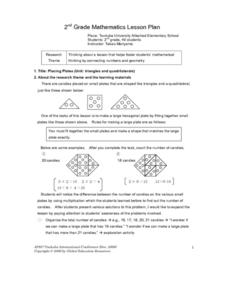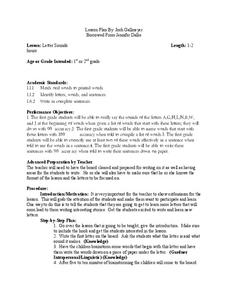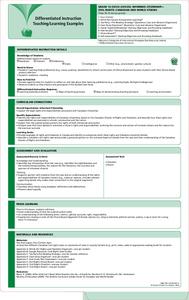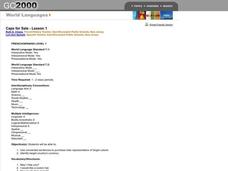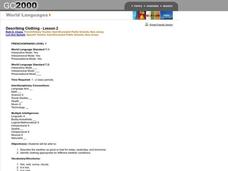Curated OER
Everyone Eats Bread
Pupils identify similarties and differences between different countries and what type of bread they eat. They examine the different cultures of countries by emailing people in other countries. They also locate the country on the map.
Curated OER
Self Assessment
Students comprehend the concept of self assessing and being able to demonstrate a self awareness to asses their own skill ability. They are each given three popsicle sticks-green, yellow and red. Students use their popsicle sticks to...
Curated OER
Teaching Biotechnology With Models
Students will construct models to obtain understanding about the scientific concept. The kinesthetic learners will benefit from the project. There is ample opportunity for all types of learners to be engaged in this lesson.
Curated OER
Treaties
Students explore Canadian maps. In this map skills and Canadian history instructional activity, students locate reserves that originated from treaties made while establishing the Saskatchewan First Nation reserve communities. Students...
Curated OER
Integrating Japanese Folk Tales into the Classroom Using Japanese Kamishibai
Students study Japanese folk tales focusing on the traditional values and key elements. They compare the Japanese values with their own. They discuss Japanese art before designing a set of kamishibai on which they write a summary of a...
Curated OER
Understanding Artifacts
Young scholars will develop a greater awareness of the things surrounding them and will be able to build a bridge between their own material culture and that of an imaginary figure from the past. This lesson focuses on the significance...
Curated OER
Inside Catlin's Head
Students will develop a variety of skills that include spatial, body kinesthetic, and communication skills. They create journal entries about the artist George Caitlin and a script for a theatrical skit.
Curated OER
Placing Plates
Second graders investigate the task of making a large hexagonal plate by putting together smaller ones. The lesson has detailed example problems for the teacher to use during direct instruction. The manipulative activities strengthen the...
Curated OER
Letter Sounds
Students orally say the sounds of the letters A, G, H, L, N, R, W, and J at the beginning of words when given a list of words that start with these letters. They use at least two of these words effectively in a sentence. Students...
Curated OER
The First Fire : A Cherokee Animal Tale
Fourth graders discover movement through the telling of "The First Fire", a Cherokee tale. Small groups are given sections of the story to tell by creating dances. Music (live and recorded) adds to the final performance and assessment.
Curated OER
To Travel or Not to Travel: Locomotor andNonLocomotor Movement
Students develop dances. In this movement lesson, students play action and stillness games and learn motif writing symbols that communicate dance moves. Students use locomotor and non-locomotor movement to create their own movement phrases.
Curated OER
See It, Say It, Move It, Do It!
Learn two new letters a week with this activity! After learning the two target letters, the class will make an alphabet video "performing" each letter. The letter's name, sound, and a motion associated with it will be included in the...
Curated OER
History of Ponce de Leon in Florida
Based in sound Educational Theory, this instructional activity uses art to convey the story of Ponce de Leon. Mild to moderately disabled students hear the story of the Fountain of Youth, examine a paining of Ponce de Leon, and act out a...
Ontario
Informed Citizenship—Civil Rights
To launch a study of civil rights, class members brainstorm rules and expectations of behaviors at home, in school, in the workplace, and in sports. They then look at civil rights cases and examine the rules embedded in these cases.
Curated OER
Cinquain
Students create an original Cinquain (five-line poem) and choreograph movement to their poem, performing movement for class and video. This lesson addresses standards in the arts and requires a video recorder.
Curated OER
Chance Dance Compositions
Fourth graders create dances through a randomly generated process (such as throwing a dice) and perform their dances for the class. Class work is based on Merce Cunningham's "Chance Dance" and includes walking, skipping hopping, and...
Curated OER
Solo Dance Composition
High schoolers conclude the semester with an individual movement study utilizing basic elements of dance and choreography previously covered in class. They will choose from three choreographic prompts presented a few days before giving...
Curated OER
Plodding Along: The Dan Wagoner Experiment
Students research Dan Wagoner and apply his choreographic ideas in "Plod" to dance study. In this art lesson, students discuss Dan Wagoner. Students select four shapes from "Plod" and connect in a dance.
Curated OER
Now That's News To Me!
Students observe how newspapers help to build a sense of community. They identify the important events and people within their school community and create a newspaper page/section. They choose photographs or clippings to use on their...
Curated OER
Caps for Sale!
If you can find the book Caps for Sale in the target foreign language, this is a great activity to accompany it! After reading and modeling the story, the teacher models a dialogue that would take place between a salesman and a customer....
Curated OER
Sandscapes to Landscapes
Students explore landscapes and create their own in a creative project.
Curated OER
Me, Myself, and I
Students visually express their personalities using writing and PhotoShop. They manipulate imagery to illustrate their written description of themselves. Students display their creations.
Curated OER
Quel temps fait-il?
Hit all the basics with this lesson, focusing on weather, greetings, and dates! Start by singing a weather related song ("Quel temps fait-il by Barbara MacArthur is suggested), and then read a story about getting ready for school. The...
Curated OER
Froggy Gets Dressed
Froggy wants to know: what are you wearing? Lead young Spanish learners through a review of weather-related terms before reading the popular children's book Froggy Gets Dressed. Then, using a froggy puppet, discuss what you're wearing...









